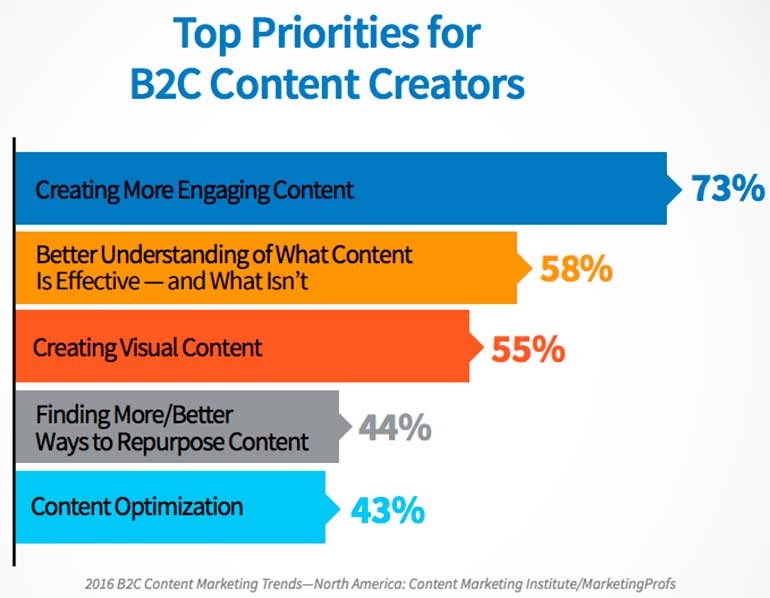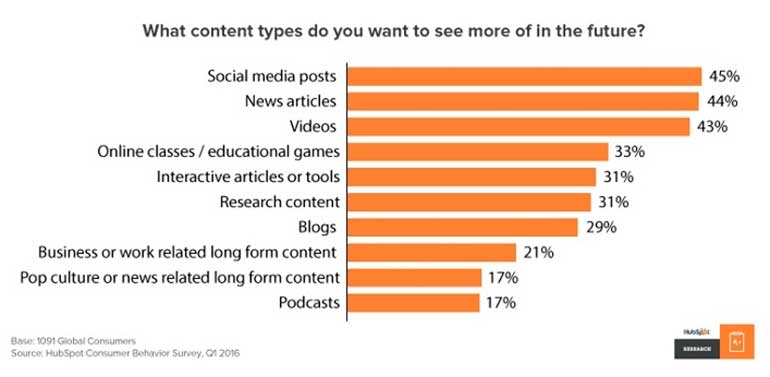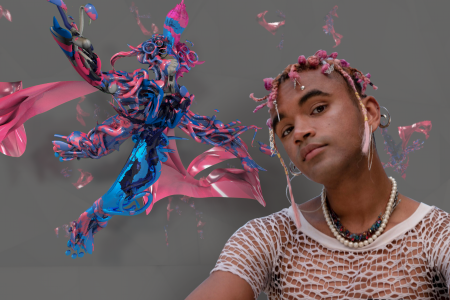Images and video are quickly becoming the main sources of traffic. With such a clear domination of visual content online, what can you do to stand out from the crowd?
We asked some industry leaders and experts for their opinion on the importance of visuals in social media marketing and the current and future trends. From this, we came up with 5 major general rules, based on the expertise and advice of industry professionals. Keep an eye out, they might just help you pave the road to your successful SMM strategy.
A few statistics before we get started:

Source: Content Marketing Institute
- When people hear information, they’re likely to remember only 10% of that information three days later. However, if a relevant image is paired with that same information, people retained 65% of the information three days later. (Source)
- 74% of social media marketers use visual assets in their social media marketing, ahead of blogs (68%) and videos (60%). (Source)
- By 2017, video content will represent 74% of all internet traffic. (Source)
5 Rules for an Effective Social Media Strategy from 3 Social Media Experts
1. Always use original visual content
Photos, GIFs and videos should become the basis of your SMM content strategy. Nothing attracts attention to a post more than an appealing image. Just remember what your Facebook or Twitter news feed looks like – hundreds of photos and videos scream for attention with just a couple of text posts scattered between them.
“Businesses can leverage the power of visuals by committing to using rich media, including photography, graphics, infographics, animations, GIFs, and quick video, across the majority of their social content. In most cases, using an image in a post leads to higher engagement than links or text updates. (On Facebook, posts with images see 2.3X more engagement than those without! source)”
– Lauren Teague, a strategist at Convince & Convert
So the question here is not whether to use visuals but rather, what kind of visuals? The main task of the images and videos is to invite users to read the text and encourage reactions (likes, shares, comments, clicks), which is why visuals should be relatable to an audience and evoke emotions.
2. Highlighting your brand’s identity: UGC and consistent style
Consistency in the style of images and quality is the main key for efficient social media presence of a brand. The main colors, topics and overall mood should be defined from the conception of a social media strategy.
“The choice between photography or illustration should be part of the brand’s visual identity. There’s room for both, of course, but content producers should have reasons for choosing one or the other to add value to their posts. Instagram is an entire social network that grew out of sharing amazing, interesting and well-edited (or filtered) photography. ”
– Lauren Teague
One more crucial point – use User-Generated Content (UGC) in your social media. Many brands turn to UG photos and illustrations as a source of authenticity and credibility. 63% of users trust UG visuals more than conventional brand images. Take a look at Instagram account of famous brands and learn their approach to the choice of visuals. Notice how many of them use UGC!
3. Re-purpose your visual content
Photos you produce or buy on stocks for blogs and articles, could be easily used for SMM, and vice versa. Which brings us to a simple thought: all of your visual content, on all your channels should support your brand identity and be shareable.
“Visuals work great on social media, as they help attract people’s attention much more efficiently than text only updates. Businesses should try to use visuals as much as possible; for example, if you’re promoting a blog post, use an image every time you share it so that you get more shares and clicks. Or, in order to boost your engagement, you can use things like image quotes, infographics and other types of engaging visuals.”
– Lilach Bullock, listed in Forbes as one of the top 20 female social media influences
4. Experiment with video
It is clear that video will dominate social media this year. Think about format and style that could be used for your social media strategy. Could it be live streaming, or a 360 degree video from an office? Maybe both? How about a short explanatory video with impressive infographics? There are plenty of options, so start experimenting!
“I think that 2017 is likely going to be the year of video when it comes to social media marketing. Video has been very successful with audiences in 2016, but I think it’s just now that businesses are really starting to grasp its importance, particularly because of the huge success of live streaming in 2016.”
– Lilach Bullock
4. Try to tell a story around your visuals
Storytelling became a buzzword and seems to be overrated, but it is still a crucial part of a brand’s visual strategy. Come up with your own style, voice, and heroes; be bold and sincere in telling your story. Regarding visuals, use a series of photos from one author and turn them into shots from your brand’s movie.
“Don’t just describe what the visual is; tell a story around it. This Nashville coffee shop does a great job with effectively marrying text and video to create a stronger post and tell a richer story with a clear tone of voice.”
– Ann Handley, Chief Content Officer at MarketingProfs
5. Embrace the future trends
What if you could target your ad based on recent photos of your audience or their real-time streaming videos? Sounds crazy, but it might happen in the nearest future, and this will take the social media game to a whole new level.
 Source: HubSpot Research
Source: HubSpot Research
“One trend I’m watching closely is how the industry begins to “listen” or more aptly, view, to gather insights about social imagery. Three-quarters of social media marketers are using visual assets in their content mix, but traditional social listening tools are still focused on pulling data only from the text of the post.
We’re just starting to be able to see and quantify what’s in an image. Marketers will soon be able to use visual search powered by image recognition to identify places, objects and actions, and glean real-time insights. When that happens, it will unlock a second layer of the social web to help marketers be smarter about their customers and their brand.”
– Lauren Teague on the future of social media marketing
Related Articles
Read top articles of the month!
Don’t want to miss any tips or industry news? Subscribe to the Depositphotos blog digest.











